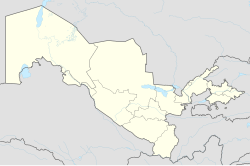Темурийлар тарихи давлат музейи / Temuriylar tarixi davlat muzeyi (Uzbek) | |
 | |
| Established | 18 October 1996 |
|---|---|
| Location | Tashkent, Uzbekistan |
| Coordinates | 41°18′49″N 69°16′44″E / 41.31361°N 69.27889°E |
| Type |
|
The Amir Timur Museum (Uzbek: Темурийлар тарихи давлат музейи/Temuriylar tarixi davlat muzeyi) is located in Tashkent, the capital of Uzbekistan. It opened in 1996, and is dedicated to the Turco-Mongol warlord Amir Timur (Tamerlane).[1][2]
YouTube Encyclopedic
-
1/5Views:10 4722 3765 42563612 478
-
Amir Timur Museum and Glimpse of Tashkent, Uzbekistan
-
TAMERLANE / AMIR TIMUR MAUSOLEUM, SAMARKHAND, UZBEKISTAN (SILK ROAD)
-
Uzbekistan/Heart ofTashkent (Amir Timur Square) Part 26
-
Amir Timur – a creator of great empire
-
Uzbekistan/Samarkand AmirTimur-"Tamerlane", Part 19
Transcription
Origin
After Uzbekistan became independent in 1991, much attention was given to the revival of the nation's spiritual and cultural heritage, including recognition of historical persons who had an important role in world civilization. Among those was Amir Temur, the warlord, politician and reformer, patron of science, education, trade, culture, and craft. Having established a great centralized state, he strengthened its power and also united many nations and people. Amir Temur's rule promoted science, education, culture, architecture, fine arts, music and poetry, laying the foundations of the Timurid Renaissance.
Former President Islam Karimov encouraged celebration of Timur, linking the Mongol ruler's achievements with the President's own style of governance.[2][3] Karimov declared 1996 to be the “Year of Amir Temur”, and the 660th anniversary was widely celebrated in Uzbekistan, and the republic subsequently resolved to build a state museum in central Tashkent, featuring the Timurid history.[4]

Opening
The ceremonial opening of the round museum structure was held on 18 October 1996 in the presence of Uzbek people and foreign guests. President Karimov stated that "The State Museum of the History of the Temurids which is opening in such a holiday conditions is the real result of the fact that in our country the historical justice towards the personality of Sahibkiran has triumphed". He compared Amir Timur Square (which is located adjacent to the museum, with a statue of Timur) to a ring, saying "the Museum is a precious stone decorating it".
Design
The museum's blue cupola resembles that of the Gur-e-Amir mausoleum in Samarkand. Though the museum was built according to the traditions of medieval architecture, it satisfies modern requirements.
Exhibits

There are more than 5,000 artifacts in the museum collection, with more than 2,000 displayed in museum exhibition halls. In particular, the museum displays focus on the genealogy of Amir Temur, his coming to power, the military campaigns of Sahib Kiran, diplomatic and trade relations, workmanship, city improvement and landscaping, and science and education development. There are also exhibits related to representatives of the Timurid dynasty, including maps, weapons, copper and silver coins, miniatures, rare manuscripts, potteries, and jewelry.
Visitors
The museum attracts more than 2 million visitors annually. It is visited by foreign statesmen and official delegations, and more than 800 such delegations have been recorded in the museum guest book.
International links
Through participation in international exhibitions, the museum has promoted its material and spiritual heritage around the world. In particular, unique exhibits were displayed at the international exhibitions as "Timurid Renaissance" in France; at Expo 2000 in Hannover, Germany; and "Bright colors: fabrics and ceramics from Central Asia" at the Powerhouse Museum in Sydney, Australia.
Education and research
The museum carries out educational work with young people, encouraging respect and love towards heritage, history, and historical figures. To this end, the museum holds spiritual enlightenment activities in collaboration with schools, colleges, and lyceums.
References
- ^ Jonathan Bloom; Sheila Blair (14 May 2009). Grove Encyclopedia of Islamic Art & Architecture: Three-Volume Set. OUP USA. ISBN 978-0-19-530991-1.
- ^ a b Antoinette Burton (4 January 2006). Archive Stories: Facts, Fictions, and the Writing of History. Duke University Press. p. 62. ISBN 0-8223-8704-2.
- ^ Sally N. Cummings (13 September 2013). Symbolism and Power in Central Asia: Politics of the Spectacular. Routledge. p. 186. ISBN 978-1-317-98700-0.
- ^ Resolution 99 of the Cabinet of Ministers of the Republic of Uzbekistan, 14 March 1996
External links
![]() Media related to Amir Timur Museum at Wikimedia Commons
Media related to Amir Timur Museum at Wikimedia Commons


